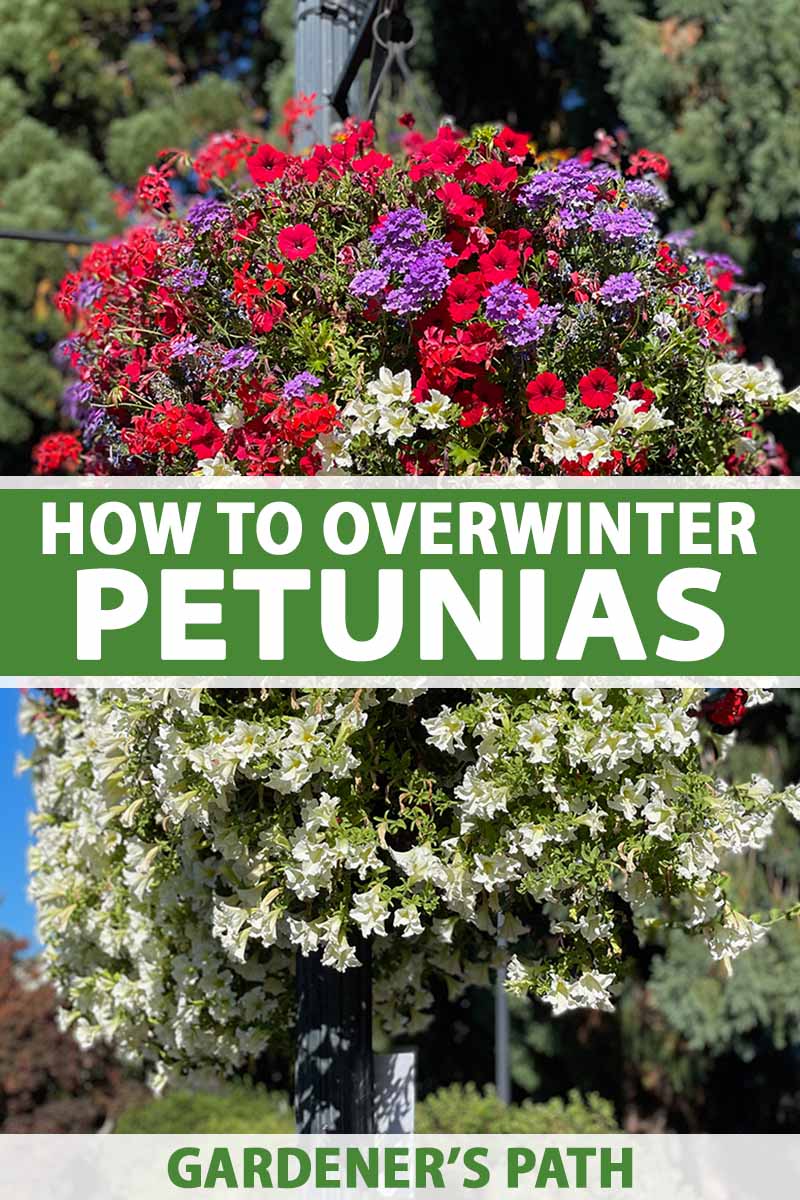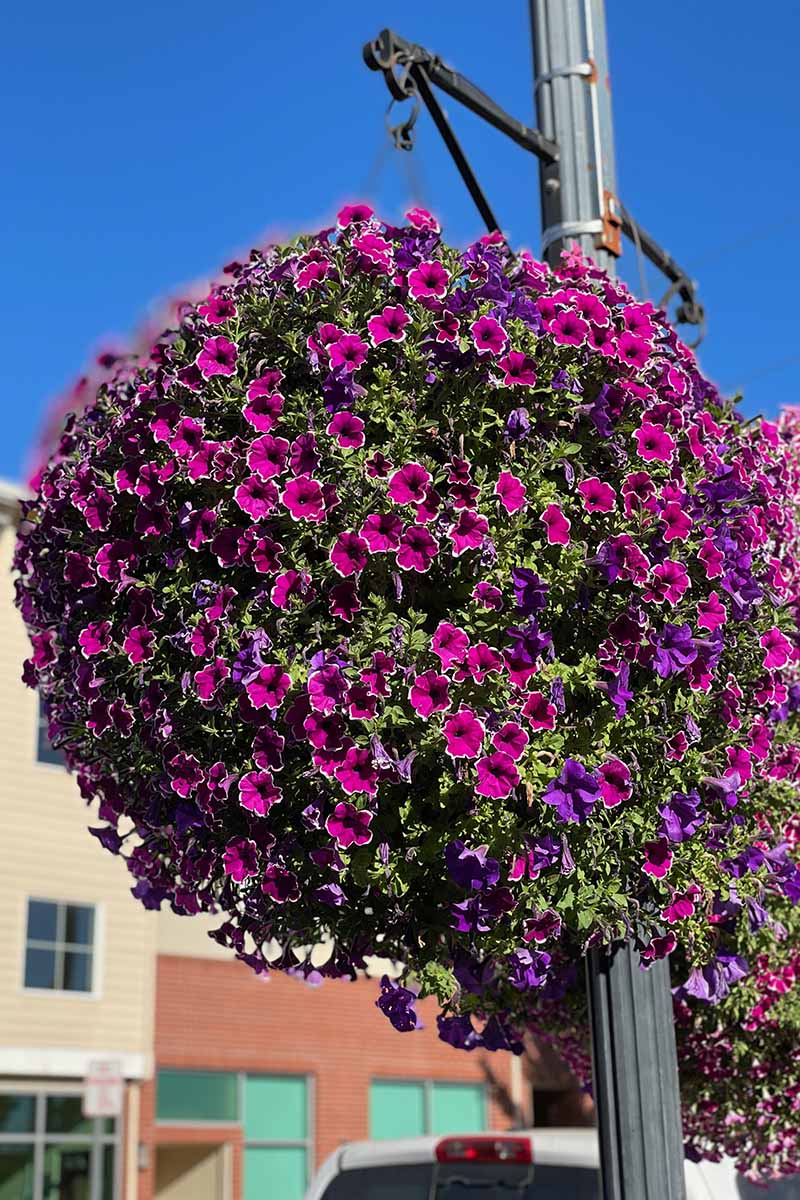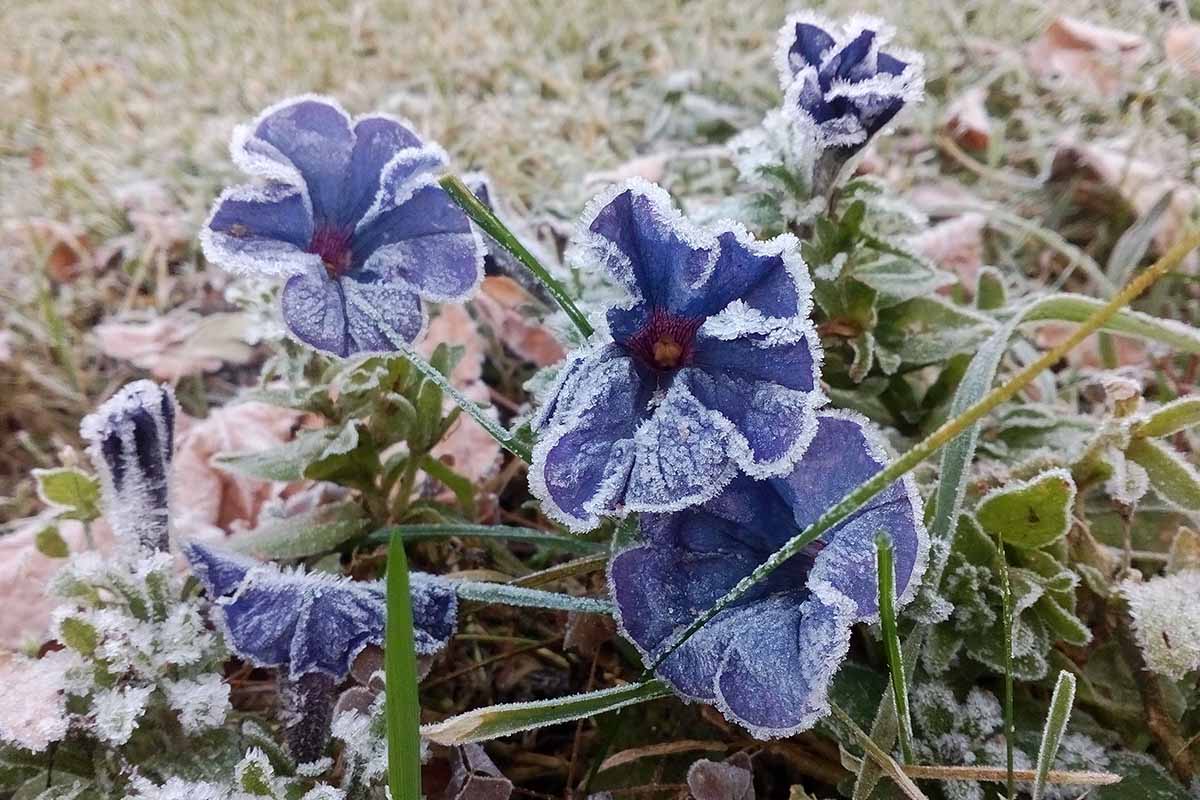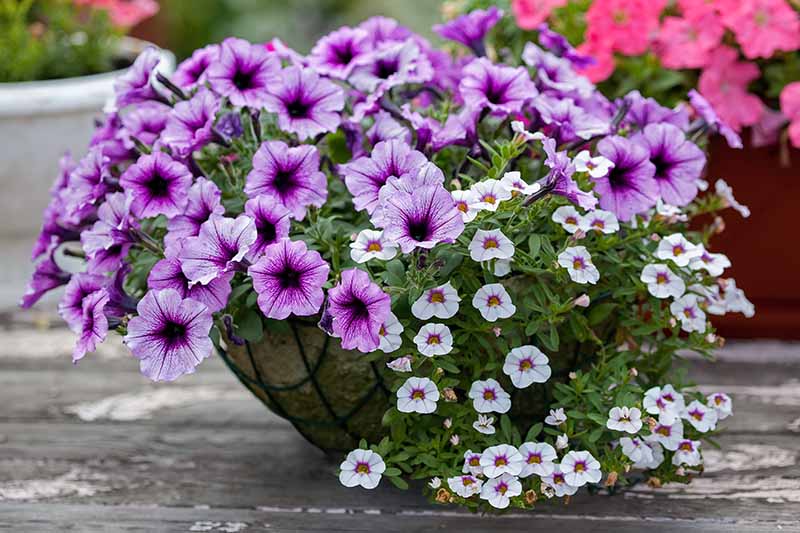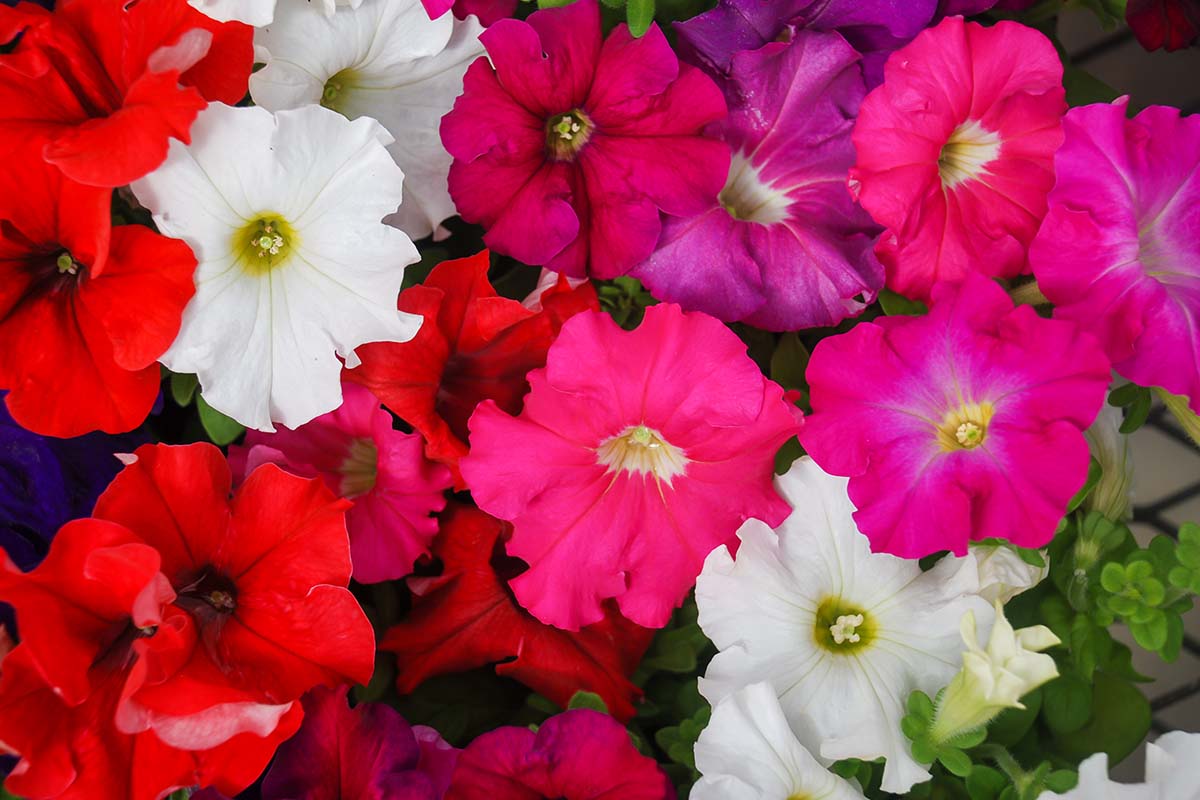Think geraniums, violets, marigolds, and of course, petunias. It’s hard to imagine a trip to the nursery in the spring without picking up a hanging basket (or three) filled with vibrant bloomers. It’s also a reliable mark of the coming winter when we gather up those hanging baskets and toss their contents into the trash or the compost bin. What many gardeners don’t realize is that petunias are technically perennials. They’re just extremely tender, and can’t handle even the slightest suggestion of frost. We link to vendors to help you find relevant products. If you buy from one of our links, we may earn a commission. So those of us in USDA Hardiness Zones 9 and below have to dig them up once the first frost sweeps over our garden, if we hope to save them. Plus, you can save a hunk of cash. If you’ve never overwintered an “annual” flower like this before, don’t feel overwhelmed. We’ll walk you through the whole process. Here’s what you can expect coming up: There’s a lot to love about petunias, but what many gardeners miss is that you can actually keep them around from one year to the next, to bloom and thrive again. Let’s figure out how!
A Bit About Petunias
Petunias (Petunia spp.) are extremely common South American native plants that can be found in most North American nurseries and home supply stores. They come in a range of sizes (grouped as grandiflora, multiflora, and milliflora, from largest to smallest) and in an endless array of colors and patterns (Black! Polka dot!). They can have an upright growth habit, or they may be vining or spreading types. We delve more into the different types of petunias here. You can find hybrids and cultivars that do best in containers, while others attain a larger size and you can use a few to fill in a garden bed. They need lots of sun, well-draining soil, and moderate amounts of water. And, as we’ve mentioned, they can’t survive in cold weather. A hard freeze will kill them. Read our in-depth petunia growing guide here. But if you live in a colder region and wish to try your hand at growing them as perennials nonetheless, you have options.
Propagation Is Also Worth a Shot
Before we jump in to tackle the topic of winter care in more detail, I’ll level with you: Petunias aren’t the best plants for overwintering. They’re shocked by the move indoors, and they will likely drop their leaves. We’re talking a real plant bloodbath with lots of foliar carnage. If this happens, the goal is to keep the roots alive throughout the dormant season so the plant can re-emerge, put on new growth, and bloom again the next season. If you have a petunia that you adore and you want to ensure it survives the winter, I wholeheartedly recommend taking a cutting, or perhaps a few. These plants propagate extremely well from cuttings, and you run less of a risk of losing an important plant if you go this route. To take a cutting, snip a six-inch or longer piece of stem and remove the leaves from the bottom half. Put the cutting in a seed-starting medium in a well-draining container. Place it in a sunny window where it will get at least six hours of sun each day, and keep the soil moist but not wet. It will develop roots, and after spending the winter indoors, you can plant it in the garden in the spring. But you can also give winterizing the entire parent plant a go as well. Let’s take a look at the available methods.
Ways to Winterize
You have two options when it comes to winterizing a petunia plant. The first is that you can put the plant into a state of dormancy somewhere that it’s protected from frost, such as in a garage. The second is to treat the petunia as a houseplant, and keep it alive in a sunny spot indoors. Keep in mind that most petunias are short-lived perennials, and will only return for about three years or so.
As Dormant Plants
This is the easiest way to keep petunias alive. While some plants, such as fuchsias and geraniums, respond well to indoor growing as houseplants, petunias can be a bit of a challenge to grow that way. This is in part because these plants naturally go dormant when the days get shorter, so you’re forcing them to grow against their nature via artificial indoor conditions. Once you know that there is a freeze on the horizon, or temperatures begin to regularly drop below 40°F, head outside and trim your petunia back. There should be no flowers left on the plant, and you should cut the stems back by at least a third. If your petunia isn’t already growing in a container, you’ll want to dig it up and knock or wash away all of the soil from around the roots. Examine the plant closely for any signs of disease or pests. You might not see pests present since many hide or leave the plant when it’s disturbed, so look for droppings, eggs, or webbing. You definitely don’t want to bring these pests or disease pathogens into your home, where they could infect any other plants you have inside. Transplant into a container that will accommodate the root ball. It should be filled with fresh potting soil and have good drainage. Now, you want to ease your plant into dormancy. Place it in the sunniest spot inside that you can provide. The plant should ideally be placed in full sun, but you can add some grow lights to supplement the available natural light if you need to. Try to mimic the length of daylight that your plants are currently experiencing outside, which means gradually reducing the amount light the plant is receiving. At first, you also want to water as you normally would. Reduce the amount by a bit each week so that a half-inch more of the soil feels dry between watering. In other words, for the first week, the soil should feel consistently moist. The next week, the top half-inch should be allowed to dry out. The following week, the top inch of soil should feel dry before you water again, and so on. All of the leaves of the plant will fall off within about a month or two. It might not be pretty, but this is okay – the plant is still alive, it has just gone dormant, focusing its energy toward the roots rather than foliage or flowers. At that point, stop watering, dispose of any remaining leaves that have fallen, and move the pot to a dark location such as your garage or basement. It shouldn’t be too warm, but your petunia should never freeze, either – a temperature somewhere around 40 to 50°F is ideal. Now, it’s time to let your plant rest. No additional watering or special care is required during dormancy, just be sure that your plants are provided the correct temperature and low-light conditions in their temporary environment. Reverse the process about six weeks before the last predicted frost date in your region, gradually adding more water and placing the pot in an increasingly sunny spot indoors. Just as you gradually reduced the light to keep pace with the waning daylight outside, you want to expose the plant to gradually increasing amounts of daylight each day. That means putting it somewhere where it will receive a few hours of indirect light and an hour or two of direct sunlight (or supplemental light). Gradually increase this over a few weeks until it can sit in full daylight. Once the last average frost date has passed for the year, as long as there is no freezing weather in the forecast, harden the petunia off for a week before putting it back outside full-time. By this time, the plant should have new foliage and should start growing again. Hardening off requires that you put the plant outside in a protected spot with indirect sunlight for an hour, and then bring it back indoors. The next day, give it an extra hour outside. On the third day, add another hour, and so on, adding more time until it’s able to tolerate a full day in the sun, and it’s ready for its return to the great outdoors. At this point, you can treat your plant as you would any petunia in terms of providing water, fertilizer, and sunlight. You can put it in the ground or repot it into a larger container. Because the plant was dormant, we were able to put it in a small container, but now that it’s out of dormancy, it will need more room to grow. Our guide to growing petunias has all kinds of helpful tips to make sure your plant is perfectly content in the garden.
As Houseplants
The nice thing about this method is that you get to go on enjoying your petunias year-round. But the challenge is that your plant is going to want to go dormant. Petunias need a lot of sun to grow actively. Bring your plant inside as described in the section above, but don’t prune it. Just remove any blossoms and dead leaves. Put the pot in a sunny window, and add a grow light to supplement the available sunlight throughout the shorter days of winter. Your petunia needs at least 10 hours of light per day to prevent it from going dormant, so if you don’t get that amount naturally in the winter, you’ll need to turn on the grow light for part of the day. Keep the soil moist, with a texture that feels like a well wrung-out sponge. Fertilize every six weeks with an all-purpose product suitable for container-grown plants. This should keep your petunia growing all winter long (albeit probably without any blossoms), but if it does happen to drop its leaves, treat it as though it has gone dormant, as described above. Once the spring arrives, you can harden the plant off and put it back outside. The biggest bummer is that they don’t stick around when it gets chilly. But now that you’ve learned our tips for overwintering, you don’t have to give up a plant that you love. Come back and share pictures of your petunias in the comments. We love to see all the amazing varieties! And if you’re looking to add even more color to your garden, give these guides to annual flowers a read next:
Give an Old Fashioned Beauty New Life: Grow Wax BegoniaTake the Fuss Out of Verbena: A Growing GuideHow to Plant and Grow the Glorious Marigold
